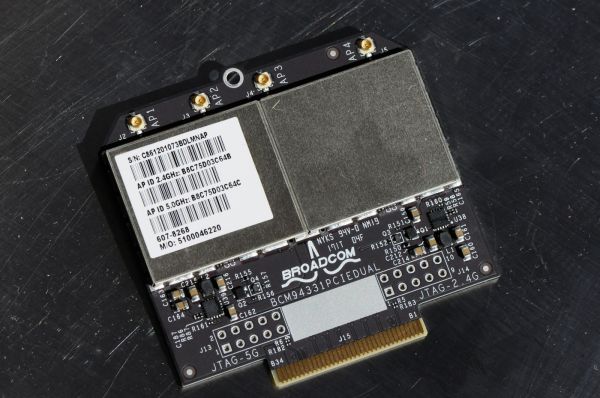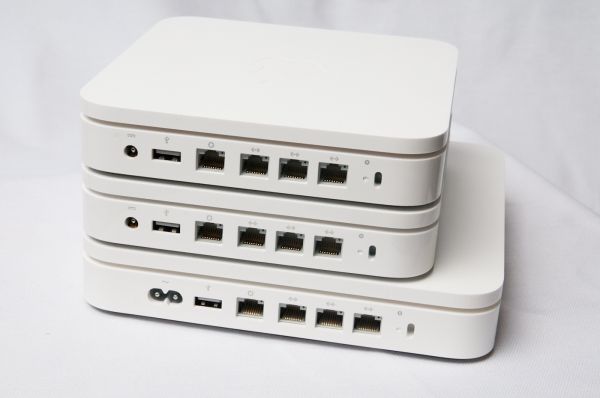Airport Extreme (5th Gen) and Time Capsule (4th Gen) Review - Faster WiFi
by Brian Klug on August 5, 2011 10:22 PM EST- Posted in
- Mac
- Airport Extreme
- Time Capsule
- WiFi
Conclusion and Final Thoughts
We’ve gone into extreme detail about the Time Capsule and Airport Extreme updates. I originally intended to have this posted with a hint of irony on WiFi day (8.02.11) but instead ended up spending that special day doing more testing and running even more instances of Iperf to make sure our numbers were solid. What’s changed between both previous generations is simple—the Time Capsule gets an official 3TB option, and both the Time Capsule and Airport Extreme now have a much more powerful, modern, and better-performing BCM4331 based WiFi stack.
The result of the move from Marvell to Broadcom is twofold. First, performance and range is definitely better thanks to more transmit power and the improved sensitivity afforded by newer generation chipsets. Second, the combination of lots of Broadcom in Apple’s hardware lineup (from the iPhone, iPad, and MacBooks, to iMac and Mac Mini) with Broadcom in the access point likely allows for the use of frame bursting or some other packet aggregation technique that speeds things up in some scenarios. It’s another example of how having that complete hardware control can in fact result in some benefit—in this case, faster WiFi.
Before this update, there were so many rumors about both iOS based Airport products, that the Time Capsule would cache software updates locally, and that the whole thing would somehow tie into Apple's iCloud solution. None of that exists right now, and it's looking like (for now) the rumor mill has some egg on its face. I waited patiently for Lion to launch and half expected things to turn on and render half of the review null; instead that day came and went without much change at all. As of this writing, the core functionality of the Airport line remains the same as it was before—sans any iCloud/iOS magic/local update caching.
There’s a stigma that Apple gear is more expensive, and for the 3TB Time Capsule that may be the case, but the Airport Extreme is actually right near where it should be. Take for comparison the Linksys E4200, which is a 2x3:2 device on 2.4GHz, and 3x3:3 on 5GHz, and also Broadcom based. That device runs for $179.99 and features similar functionality including a USB 2.0 port for sharing devices. At $179.00, the Airport Extreme offers full 3x3:3 on both 2.4 and 5GHz, albeit the E4200 does have considerably more Tx power, which we'll investigate in a forthcoming article.
I guess the reason that I personally use an Airport Extreme (in conjunction with another device for NAT) is that it's really one of a small number of 802.11n dual-band APs I've tried that actually works without locking up, becoming unstable periodically, dropping the session from overheating when being pushed to 100% for hours, or requiring a daily reboot. There are just so many other consumer level 802.11n APs that either fall short or are incredibly frustrating and unreliable. Thus far, I've been using an Airport Extreme Gen 5 and Time Capsule Gen 4 as my primary AP with over 12 devices attached to each one for the greater part of a month without a single instability. It's that kind of stability that really sells it for me, even with 3x3:3 out of the picture.
That kind of sums up WiFi in general—ideally, it should work and be something transparent to the user instead of a constant consideration. I wager the vast majority of Airport Extreme and Time Capsule owners have no idea what 3x3:3 is or how to even check their physical link rate, and for the most part that's a testament to how stable these devices are. Maybe that's the reason why Apple doesn't make a super huge note about changes like markedly improving their WLAN connectivity. One thing is for certain, Apple's wireless division is either playing it incredibly cool, or honestly not getting the credit it deserves.













90 Comments
View All Comments
jackwong - Sunday, August 14, 2011 - link
It is more about the data on the TC, and it runs EXTREMELY hot during Summer...This is my setup, Airport Extreme base station, Synology 1 bay with 2TB, and a Sesgate goflex 2.5" 1.5TB to backup the Synology. These cost me ~$550 but if the nas has problem, I can still have all the data on the 1.5TB Seagate.
name99 - Saturday, August 6, 2011 - link
Then don't buy one.Connect a USB drive to your Airport base station.
Or use network time machine to back up to whatever home server/HTPC mac you have sitting around. That's what I do.
I honestly do not understand why people feel compelled to tell the world: "this product is a bad match for me and my needs and therefore no-one should ever use it".
Do you apply the same logic to, I don't know, Intel chips? Damn those Xeon's are expensive --- and they even run at slower rates than my i5. Anyone who buys one is obviously an idiot.
HilbertSpace - Saturday, August 6, 2011 - link
Did you try putting the mini Broadcom PCIe into the Gen 4 Airport Extreme and seeing if you can do an upgrade that way?Brian Klug - Saturday, August 6, 2011 - link
I considered it for a long time, but decided that I wasn't sure it was worth spending too much time on (particularly because I have no idea where you could buy just the card) and because there's ostensibly some firmware flash that must go along with the Gen 5. I'm not sure whether there's a way to force a firmware update with the Gen 5 firmware on a Gen 4.-Brian
Signalius - Monday, October 29, 2018 - link
Now that it’s 2018 and these units can be found at thrift stores for $10, is there any sense in attempting to improve an A1301 (3rd gen) Extreme with the wifi card from a dead A1408 unit?hechacker1 - Saturday, August 6, 2011 - link
The only missing feature IMHO is some type of QoS management and uPNP.I have a 4th Gen Airport Extreme, and as you say it's a stable router that just seems compatible with everything (everything connects reliably).
I'd love to upgrade to the 5th Gen for the extra power (that's surprising Apple cranks it up that high), but when it comes to using p2p and gaming at the same time, the lack of QoS prioritization kills it.
Then it doesn't have uPnP, which more broadly supported than NAT-PMP. The Airport also has a nasty bug of forgetting your port forwardings and MAC address bindings, as soon as the network card sleeps for too long (a few hours).
So it's back to a router that supports more open features and can also have its radios power cranked up to match the Airport. There's a few good dual band routers out there are are pretty much all open source (even the wireless chip!).
Zok - Saturday, August 6, 2011 - link
Like what? I bought a Netgear WNDR3700 quite some time ago because it was one of the highest performing dual band / dual radio devices at the time (supposedly the SoC was faster than it's competitors).That said, it's been an absolute nightmare to get DD-WRT on it and stable (radio performance and range gets trashed) and the factory GUI is severely lacking (doesn't allow for PAT, for example). Have any suggestions on something DD-WRT compatible, but can also drive dual radios for both bands (2x2 or 3x3, 40 MHz on both, preferable)?
hechacker1 - Saturday, August 6, 2011 - link
I'm using OpenWRT on the 3700v2. Check out the OpenWRT forums for community builds that let you set the radios to their max power output (24dBm on 5GHz 40MHz, 27dBm on 2.4GHz 40MHz). It reaches the hardware limit.Surprisingly, the new Airport Extreme has slightly more power output at 5GHz than the 3700v2.
OpenWRT has been stable on this router for me. It's a great alternative to the Airport if you want LOTS of power output and open source software with tons of features.
The biggest con with OpenWRT is that its interface sucks; but whatever, you only have to set it up once.
name99 - Saturday, August 6, 2011 - link
uPNP I couldn't give a damn about, and neither can Apple.They have their solution for devices transparently connecting to each other, in the form of Bonjour, and that's not going to change. Like NAT-PMP it's an IETF standard and, for all the complaints otherwise, Apple is actually a pretty standards compliant company.
The two obvious (IMHO) missing features (which could both be added with software, at least to some extent) are QoS and transparent caching (most easily by running squid on the device and having it store the cache on any attached storage --- stick in an 8GB USB flash drive if you have nothing better). I continue to think that the rumors regarding base stations being part of iCloud will likely prove true in the long run --- it's to Apple's obvious advantage to be able to offload as much work to base stations as possible via transparent caching.
I also have no idea what the complaint about "forgetting your port forwardings" refers to. I used a 3rd gen extreme for years, and switch to a 4th gen about six months ago, and I have NEVER had my port forwardings forgotten or borked in any way.
Personally if someone is going to complain, the real item to complain about is the USB performance which was so crappy it was unbelievable in the 3rd gen, and appears unimproved even today. Come on, Apple --- even if the Marvell chip is garbage, spend the extra buck and buy a decent 3rd party USB controller. I think the best we can hope for is that the 6th gen device uses an upgraded Marvell chip with a USB3 controller that is lousy by the standards of USB3, but gives at least say 60MB/s.
edporras - Tuesday, August 9, 2011 - link
QoS would definitely be handy but not having the ability to forward port 53 just killed me. I really wish there was a way to disable the ABS' DNS server. Or if anyone has figured it out, please share.